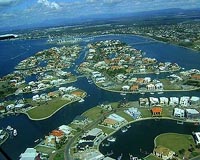| . |  |
. |
Canberra, Australia (SPX) Apr 22, 2010 Evidence that the world's water cycle has already intensified is contained in new research to be published in the American Journal of Climate. The stronger water cycle means arid regions have become drier and high rainfall regions wetter as atmospheric temperature increases. The study, co-authored by CSIRO scientists Paul Durack and Dr Susan Wijffels, shows the surface ocean beneath rainfall-dominated regions has freshened, whereas ocean regions dominated by evaporation are saltier. The paper also confirms that surface warming of the world's oceans over the past 50 years has penetrated into the oceans' interior changing deep-ocean salinity patterns. "This is further confirmation from the global ocean that the Earth's water cycle has accelerated," says Mr Durack - a PhD student at the joint CSIRO/University of Tasmania, Quantitative Marine Science program. "These broad-scale patterns of change are qualitatively consistent with simulations reported by the Intergovernmental Panel on Climate Change (IPCC). "While such changes in salinity would be expected at the ocean surface (where about 80 per cent of surface water exchange occurs), sub-surface measurements indicate much broader, warming-driven changes are extending into the deep ocean," Mr Durack said. The study finds a clear link between salinity changes at the surface driven by ocean warming and changes in the ocean subsurface which follow the trajectories along which surface water travels into the ocean interior. The ocean's average surface temperature has risen around 0.4 degrees C since 1950. As the near surface atmosphere warms it can evaporate more water from the surface ocean and move it to new regions to release it as rain and snow. Salinity patterns reflect the contrasts between ocean regions where the oceans lose water to the atmosphere and the others where it is re-deposited on the surface as salt-free rainwater. "Observations of rainfall and evaporation over the oceans in the 20th century are very scarce. These new estimates of ocean salinity changes provide a rigorous benchmark to better validate global climate models and start to narrow the wide uncertainties associated with water cycle changes and oceanic processes both in the past and the future - we can use ocean salinity changes as a rain-gauge," Mr Durack said. Based on historical records and data provided by the Argo Program's world-wide network of ocean profilers - robotic submersible buoys which record and report ocean salinity levels and temperatures to depths of two kilometres - the research was conducted by CSIRO's Wealth from Oceans Flagship and partially funded by the Australian Climate Change Science Program. Australia's Integrated Marine Observing System is a significant contributor to the global Argo Program.
Share This Article With Planet Earth
Related Links CSIRO Marine and Atmospheric Research Water News - Science, Technology and Politics
 New Coastal Research Body To Turn Science Into Action
New Coastal Research Body To Turn Science Into ActionCanberra, Australia (SPX) Apr 22, 2010 An A$11 million collaboration aimed at helping Australia translate science into practical applications for adapting to climate change, population growth and other coastal pressures will be launched in Perth. Led by Curtin University of Technology, the CSIRO Flagship Coastal Collaboration Cluster will tackle the challenge of how to present and communicate scientific results in ways that are ... read more |
|
| The content herein, unless otherwise known to be public domain, are Copyright 1995-2010 - SpaceDaily. AFP and UPI Wire Stories are copyright Agence France-Presse and United Press International. ESA Portal Reports are copyright European Space Agency. All NASA sourced material is public domain. Additional copyrights may apply in whole or part to other bona fide parties. Advertising does not imply endorsement,agreement or approval of any opinions, statements or information provided by SpaceDaily on any Web page published or hosted by SpaceDaily. Privacy Statement |